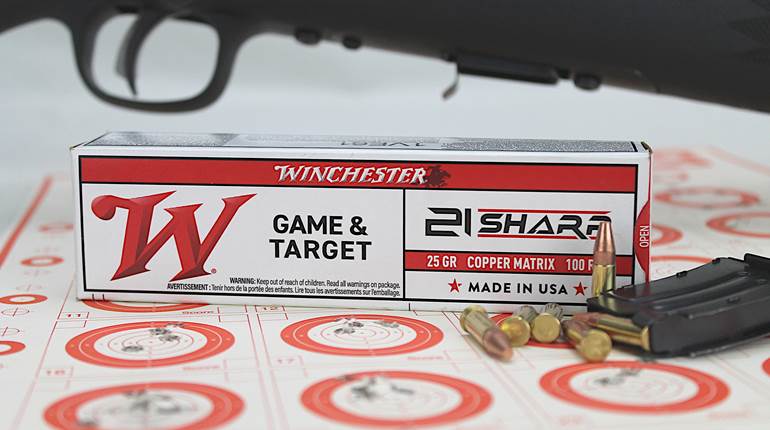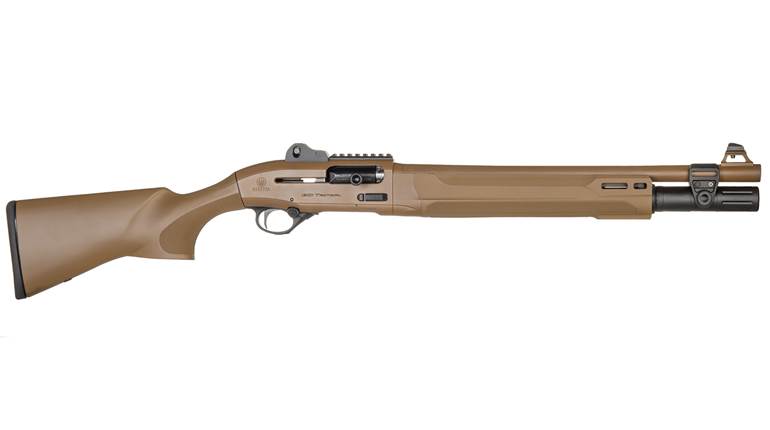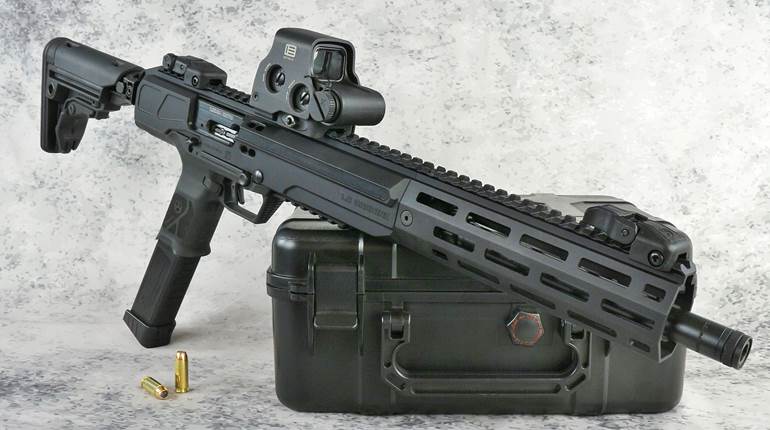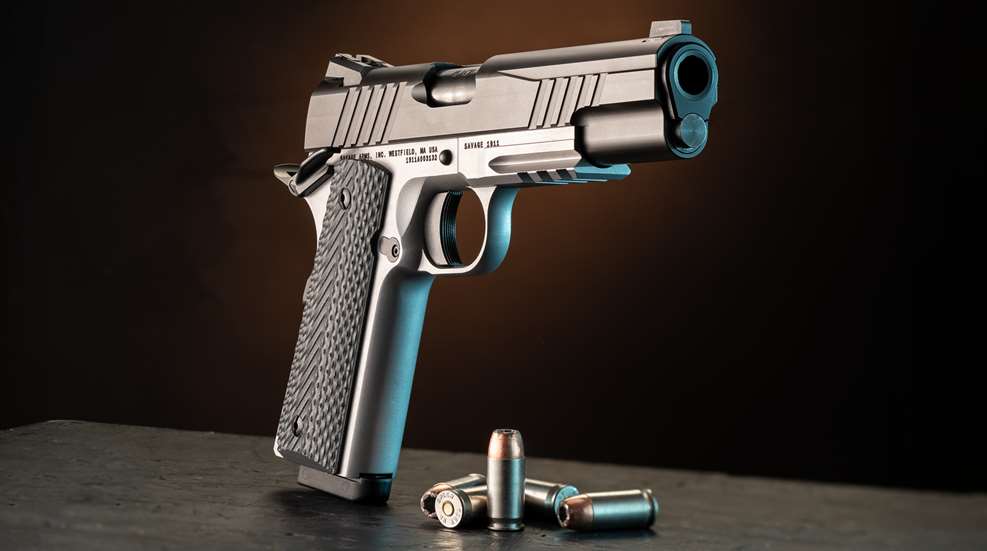
The long, rich history of Savage Arms can be traced back to 1891 when Arthur William Savage received a patent for a repeating lever-action-rifle design. By 1894, he had formed the Savage Repeating Arms Co. in Utica, N.Y., to sell his Model 1895 lever-action rifle after several failed bids for military contracts. The Model 1895 would evolve into the iconic Model 99 lever-action.
In 1904, the U.S. Army sponsored the Thompson-LaGarde military sidearm tests, which concluded with a report stating, “... a bullet which will have the shock effect and stopping power at short ranges necessary for a military pistol or revolver should have a caliber not less than 0.45 inches.” In 1906, the Army invited armsmakers from around the world to participate in a head-to-head practical competition to find a semi-automatic pistol that would replace the Colt New Service revolver. Despite the allure of a potentially lucrative military contract, only a few manufacturers submitted entries for this test, including the American gunmakers Colt’s Mfg. Co. and Savage Repeating Arms Co.
When the pistol trials began, Colt’s semi-automatic pistols were already enjoying commercial success. Savage, on the other hand, had yet to produce any pistols at all, let alone handguns for the military. Savage decided to enter the market using a pistol designed and patented by inventor Elbert Searle. Because the Army rescheduled the tests to begin in January 1907, Searle was able to complete the first gun, dubbed the 1907 Savage, just ahead of the deadline.
After various models underwent rigorous testing, the Army outlined the modifications and upgrades it was looking for and offered Colt, Luger and Savage contracts to submit improved pistols for field trials. Luger would decline this offer, leaving the Colt and Savage designs in a head-to-head competition during the next few years. During this time, Savage also developed a .32 ACP version of its pistol for civilian sales.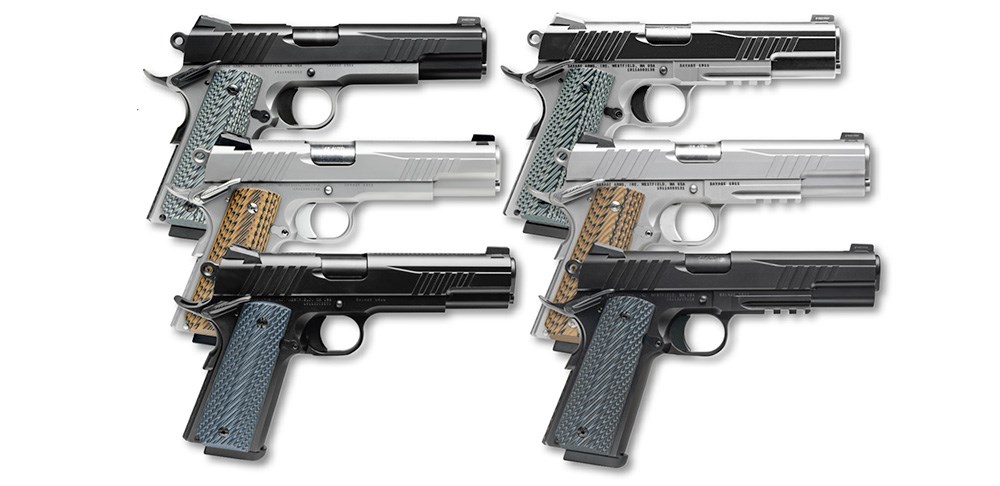
In the spring of 1911, the .45-cal. Colt Model 1911 and the improved 1907 Savage, now called the Savage Model 1911, faced off for the last time in a 6,000-round marathon endurance test. In the end, the Colt pistol prevailed and went on to become the now-iconic M1911. As some historians have noted, the stiff competition with Savage contributed to the refinement of the M1911 platform, which led to its adoption and place in military and shooting sports history. Although the 1907 Savage would not play a role in U.S. military combat, the more svelte .32 ACP version was adopted for use by French and Portuguese troops during World War I. Additional variations and chambering options served as civilian defensive pistols until the line was discontinued in 1928.
In the near century that followed, Savage kept its manufacturing endeavors focused primarily on long guns. Today, the company boasts an impressively diverse selection of rifles and shotguns enjoyed by many American shooting enthusiasts. Although handguns have not been a high priority, the company has offered a few interesting and unusual options along the way. The Model 101, styled to look like a revolver, was a single-action, single-shot rimfire offered from 1960 to 1968. There was also the Savage Striker, which was manufactured from 1999 to 2005; this composite-stock, bolt-action pistol was assembled around the Savage Model 110 action for handgun hunting and metallic silhouette competition.
In 2022, Savage stepped firmly back into the handgun market with two new models. One was the Savage 110 PCS, essentially a revival of the Striker bolt-action pistol but with a few modern updates including a one-piece aluminum chassis system. The other was the company’s first defensive semi-automatic in nearly a century: the Stance. This polymer-frame, single-stack 9 mm Luger fits neatly into the everyday-carry niche of the sub-compact pistol market. When I had an opportunity to work with the Stance, I was impressed with how well it moderated the snappy levels of felt recoil commonly produced by pistols in this class.
As 2023 rolled around, it seemed likely that Savage would continue to diversify its handgun offerings. It would have been reasonable to expect additional polymer-frame 9 mm options, since that continues to be a hot category in personal-protection circles. Instead, I was surprised to learn that the company would be adding its own interpretation of its old rival, the M1911 semi-automatic pistol. I was intrigued by this choice and eager to see what the company had in mind. The answer was reassuring. The Savage 1911 lifts its design cues directly from John Moses Browning’s classic recoil-operated, single-action, semi-automatic pistol. Although this series treads familiar ground, offering no surprises for those familiar with the M1911 platform, it’s obvious that these guns were carefully thought-out so as to provide a desirable feature set in an already crowded marketplace.
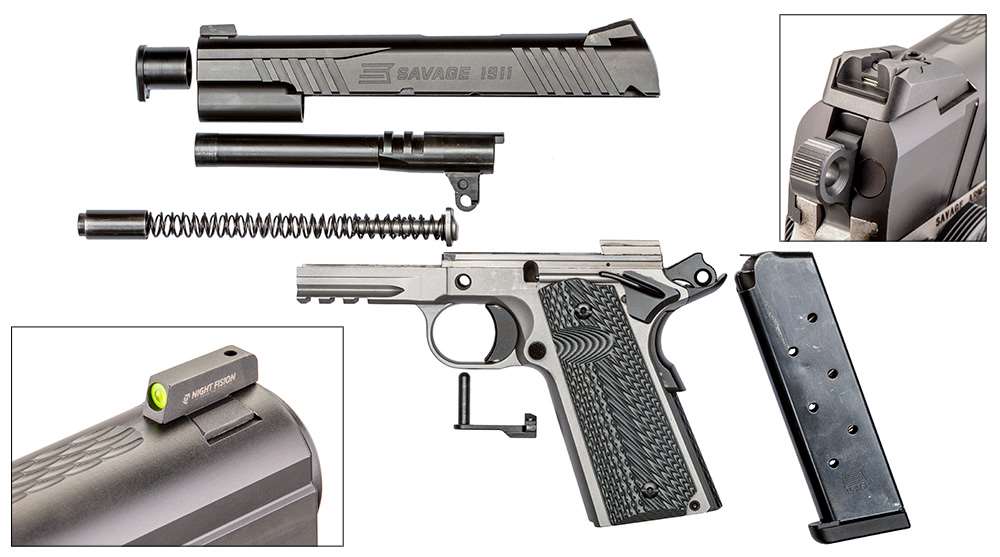
For the most part, factory-assembled M1911 pistols fall into roughly three price-point categories. Budget-friendly models, a good number of which are imported from the Philippines, Turkey and Brazil, sport suggested retail prices in the neighborhood of $400 to $900. The next step up the ladder leads to the “factory-custom” guns, which can run anywhere between $1,200 and $1,800. After this group, there are the fully customized pistols, for which the sky is the limit; pistols in this class can easily cost $3,000 or more. Savage opted to enter the M1911 marketplace with factory-custom pistols in the $1,349 to $1,499 price range, depending on the features selected. It was a good choice, as it allows the company to offer upgrades and a level of refinement that is usually unavailable in budget-priced pistols, while keeping these new guns fiscally obtainable for those M1911 fans who prefer more feature-rich options.
The Government-size Savage 1911 pistol is initially being offered in .45 ACP and 9 mm Luger. This series features forged 416 stainless-steel slides and frames. It’s not uncommon to find cast components in less expensive guns because they are more affordable to produce. But forged steel extends the working lifespan and reliability of those components subjected to the heat and stress produced by firing large quantities of ammunition through semi-automatic pistols.

Finish options include a total matte-black nitride treatment, a natural matte stainless-steel silver or a two-tone option with a black-nitride slide and appointments fitted to a silver frame. Customers can choose a frame with either a traditional rounded dustcover or an integral dustcover accessory rail. The two-tone model chambered in .45 ACP, with an accessory rail (Model 67207), was used for this evaluation.
While the Savage 1911 slide is fundamentally of the classic, round-top variety, its top features a central 0.30"-wide section of milled-in texturing to reduce glare. The front sight of the pistol tested is the dovetailed metallic Night Fision Glow Dome night sight with a large, bright yellow dot outlining a tritium lamp. At the rear is a drift-adjustable Novak Lo-Mount sight secured by a tension screw. The bottom edge of the square notch is augmented by a thin, horizontal tritium bar. In daylight, this sight set is quick-to-acquire and easy-to-use. The configuration of the front and rear tritium lamps is exceptionally useful in low- to nearly no-light conditions.
The slide is cut with a set of canted cocking serrations at the front and the rear. The front serrations have a subtle swooping bevel that nicely highlights the shape of the slide without calling undue attention to it. The ejection port has been lowered and flared for more reliable operation. Looking through the top of the ejection port, one can see a minute witness hole in the top of the barrel’s chamber that serves as a simple visual loaded-chamber indicator.

The 5" linked barrel is made from stainless steel and features an 11-degree target crown. For this particular model, it is treated with a matte-black nitride finish to match that of the slide, barrel bushing and recoil spring plug. The bushing exhibited tight and precise fitting to both the slide and the barrel’s muzzle.
One of the longstanding debates with modern M1911 pistol design is whether to install a full-length guide rod or to use the original stubby guide to support the recoil spring. I’ve worked with both configurations and can see the advantage that each has to offer. In this case, Savage installed the short spring guide, which supports two nested, round-wire recoil springs. Based on the range results, the use of the short guide did not impede either the gun’s operational reliability or its accuracy, so it still seems to be the same viable option today that it was when Browning configured it more than a century ago.
Savage chose to invest in internal upgrades for this pistol, including a durable, wear-resistant, nitride-coated, titanium firing pin. The sear is fully machined from tool-grade steel, as is the disconnector. The slide rail and ejector configurations are typical for the M1911 design. The dustcover of this gun’s silver frame has a milled-in 1.75" long, three-slot, Picatinny-compatible accessory rail suitably sized for a variety of light and laser sight modules. I found no markings on the left side of the frame. On the right side, from the top of the grip to the accessory rail, the words “SAVAGE ARMS, INC. WESTFIELD, MA USA SAVAGE 1911” are laser-engraved, with the serial number appearing below them.
The traditional rounded trigger guard has been lightly beveled where it meets the grip frame for improved shooting-hand comfort. The grip frame, behind the trigger guard, is also beveled for easier trigger reach. It houses a blackened aluminum trigger with a curved and grooved face. This trigger does not have the weight-reduction holes or overtravel-stop screw often favored for competition pistols. The feel of the single-action trigger pull is often what makes or breaks an M1911, and the Savage did not disappoint. The trigger was smooth with just a hint of take-up before breaking cleanly at 3 lbs., 13 ozs.
The left-side slide stop and round-button magazine release are M1911-style, with the top of the release button cut with fine-line checkering for improved purchase. The bilateral thumb safeties have narrow grooved extensions suitable for general shooting and concealed carry. The commander-style, skeletonized hammer is machined from stainless steel. The grip safety features an extended beavertail, to prevent hammer bite, along with a memory bump.
The full-size grip frame’s frontstrap is smooth and untextured, while the straight mainspring housing is milled with the same style of texturing found along the top of the slide. All Savage 1911s ship with VZ Grip’s top-notch textured G10 stock panels. This laminated material is strong and lightweight, and it can be grooved or textured for improved purchase without being overly abrasive to bare hands. The pistol’s grip has a black-and-gray color scheme, with other models sporting black-and-blue or black-and-tan layers. The left-side panel has a thumb-notch bevel to allow better access to the magazine release.
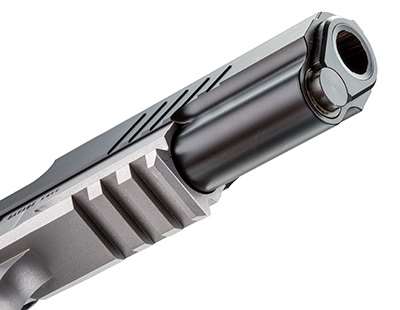
It is a common practice for manufacturers of M1911 pistols in this class to ship the guns with just one basic seven-round magazine. Their logic is that customers willing to buy guns at this price point usually trade out the factory magazines for those they prefer. Nevertheless, this practice is irksome considering that other types of semi-automatic pistols, which cost significantly less, often arrive ready to use with two or even three magazines in the box. For this reason, I appreciate the fact that the Savage 1911 ships with two eight-round magazines fitted with extended polymer bumper-style baseplates. This gives customers a useful starting point while they sort out their magazine preferences.
As mentioned earlier, M1911 pistols in the factory-custom class are more refined than less expensive guns. This is certainly the case with the Savage .45 ACP. The machining and fitting throughout is excellent; the slide is fitted tightly to the frame to wholly eliminate the “G.I. wiggle” found on some M1911s. The slide cycled smoothly from the first time the chamber was checked, without the roughness exhibited by some models when they leave the factory. The various edges are properly rounded, and the controls operate smoothly and properly, including the thumb safety clicking tightly into its Safe and Fire positions. The individualizing touches, including the front slide serrations, the mainspring housing texturing and the G10 stocks, are tastefully executed in such a way as to make this pistol series appealing to more tactically minded enthusiasts without alienating the traditionalists in the crowd.
In this, the golden age of sub-compact, polymer-frame 9 mm carry pistols, time spent at the shooting range with the Savage 1911 proved to be a good reminder of why this platform is still going strong more than a century after its conception. With its all-stainless-steel construction, this full-size pistol tips the scales at 40.9 ozs. with an empty magazine inserted in the grip. This weight, in conjunction with the hand-filling grip, lends to more moderate, manageable levels of recoil when shooting .45 ACP. It’s more of a good, solid shove compared to the often-snappy kick of sub-compact 9 mm pistols that can weigh less than 20 ozs. The useful sight system and the light trigger pull also contributed to the enjoyable shooting experience.
Informal and formal testing included ammunition ranging from practice-grade “hardball” loads to the latest defensive hollow-point bullet designs. Manufacturers of all-steel M1911 semi-automatics usually recommend a break-in period of 200 rounds or so; this allows the machined steel components to settle in and smooth out. However, this pistol fed, fired and ejected all of the ammunition used in it without any jams or malfunctions throughout the entire course of fire. With such a tight slide-to-frame fit, I expected at least a few malfunctions within the first 50 to 100 rounds, but that was not the case. The pistol did not exhibit any mechanical issues either. In short, it was satisfyingly smooth sailing from the first round fired.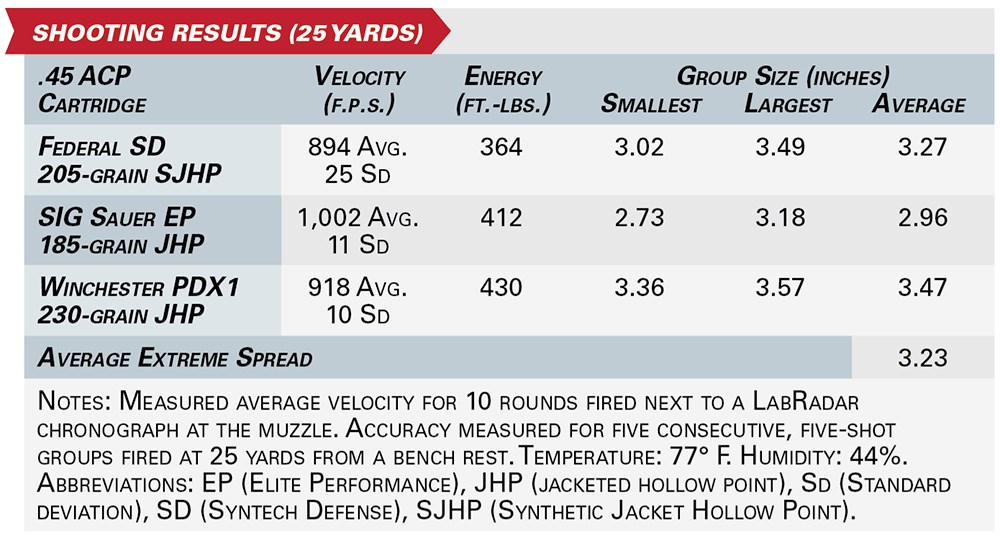
When considering the Savage 1911’s downrange performance, I can’t help but reflect on a magazine article from about two decades ago. As I recall, the author spent a then-exorbitant sum of $3,500 (more than $6,000 today) to ship his favorite M1911 off to a gunsmith to be fully customized. He was proud of the gun, and rightly so, because the gunsmith did good work. The finished pistol proved to be capable of 3.5" groups at 25 yards, and he was quite pleased with the results.
I mention this here because some readers flinch at the notion of spending $1,500 for an M1911 these days. But with today’s modern production techniques and Savage paying attention to the details of its version of this pistol, the performance and features are just as good or better than what previously cost much more. Firing from a bench rest at 25 yards using the factory-installed sights, the Savage 1911 demonstrated sub-3" group potential with five-shot groups ranging from 2.73" to 3.57" in size and an average extreme spread of 3.23".
Since I began writing for NRA Publications, I’ve taken advantage of the opportunities that have come my way to work with Savage firearms. This has included time testing the company’s bolt-action hunting rifles, break-action shotguns, semi-automatic rimfires and the polymer-frame Stance concealed-carry pistol. In all cases, the test guns have met or exceeded my expectations. This company succeeds in packing handy feature sets and reliable operation into their guns while maintaining fair prices for their customers. I’m glad to see the company continuing to grow and diversify.
Sometimes stepping into a new-to-the-company facet of the firearm market can be a tricky process. It’s not uncommon for early products to require some inline changes or fine-tuning to reach their full potential. I’m happy to report that this is not the case with Savage’s 1911 pistol series. These guns are fully mature, ready-for-market products with quality workmanship and features that match their price tags. These pistols can comfortably go toe-to-toe with other factory-custom guns that have been available for years. Now that this company has adopted the once-rival M1911 platform as part of its catalog, I look forward to seeing what it chooses to do next.












